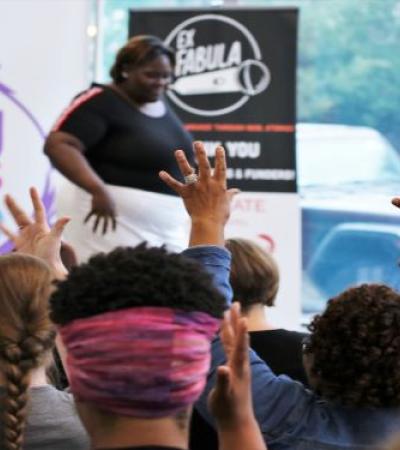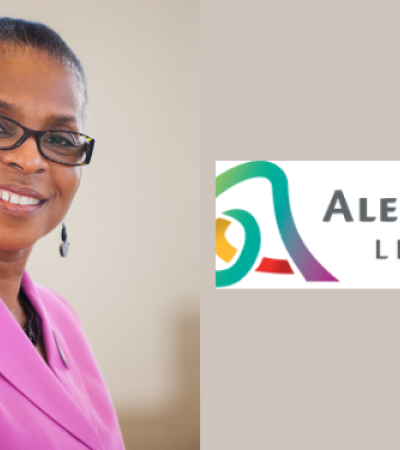On August 21, 1939, five Black men asked to register for a library card at the white-only Alexandria (Va.) Library. After being turned down, each sat silently at a different table and began to read a library book. Police officers arrested the group and charged them with disorderly conduct.
More than 80 years later, the Alexandria Library was named the 2020 winner of the ALA Excellence in Library Programming Award for its program, We Are the Alexandria Library Sit-In. The yearlong celebration marked the anniversary of the historic protest — one of the first sit-ins of its kind in the nation.
Library Director Rose Dawson spoke with us about the celebration’s planning process, how she learned about the protest and how she views libraries as essential spaces for bringing awareness to past historical events, especially histories that are problematic.
>>>Watch a webinar about the award-winning We are Alexandria Library Sit-in program series.<<<
 How did you learn about the 1939 protest when you began your role at the library?
How did you learn about the 1939 protest when you began your role at the library?
In 2005, I became the first African American deputy director of the library. My special collections staff were the first ones to tell me about the protest. They presented me with all this documentation, and I thought, wow, I have never heard about this before! I grew up in North Carolina, so I knew all about the sit-in that occurred at the Woolworth counter, but I had no idea about the library sit-in.
I took a special interest in the protest and started educating myself. On the weekends, I would come down to the branch and have the special collections staff pull records for me.
At a certain point I said to myself and to my staff, “We need to celebrate this story!” The 70th anniversary of the protest was coming up in 2008, and I knew we needed to acknowledge it. The protest was widely known in the Alexandria’s African American community — the anniversary was typically celebrated in somebody’s backyard — but the protest was not known on a wider scale. I wanted to change that.
But you ran into some road bumps?
As we approached the date, I found out that my special collections staff, who take care of all the library’s history, were uncomfortable with planning a celebration. Especially one where we were on the wrong side of history.
Uncomfortable how? How’d you get around that?
My staff was uncomfortable because the anniversary had always been the domain of the Alexandria Black History Museum. The museum is housed in the old Robinson Library building — the African Americans-only library, the facility that was built in 1940 as a result of the sit-in. The museum made an insightful documentary on the protest back in the ‘90s.
I could appreciate my staff being concerned that we were taking this celebration away from the museum, but it is a major part of our history, the library’s history. I felt compelled to do right by it! We ended up partnering with the museum for the 70th anniversary, and it was a huge success with a great turnout and a lot of community participation.
I love how that all came together with the museum! That was in 2008, so you must have kept celebrating the anniversary. Is that right?
In 2014, for our 75th anniversary, I determined that we needed to do it big. It needed to be a yearlong celebration done by the entire library system.
As director, I made it clear that I had high expectations, and I needed my staff to know as much about the protest as possible. As an ALA member, I also felt like the wider library community needed to know about it. We started planning for the 75th anniversary a year ahead.
What was that planning process like?
I created an internal staff committee and an external committee for the 75th. The internal committee met monthly. The external committee met less often. They worked as advocates to make the community aware of this yearlong event.
For the 75th, we closed off the street in front of the library. Nonprofit community partners came and set up tables, we invited a speaker, we had music, and we had food. It was a real celebration, and we got a lot of press.
When I sat down to debrief with my staff, we saw that we had checked off so many fantastic boxes except for one: we had not incorporated the families of the original protesters into the festivities. I told my staff then, when we come together again for the 80th, we are going to prioritize these families. They are going to be the driving force in how we celebrate this event.
We had four years to try and establish contact and relationships with the families to get them to participate. And that was a success because for the 80th, you had family members participating!
What was the process of finding them and getting them to participate like?
I put out a call for staff to volunteer to help find descendants. I was expecting to get representation from each library department, and I ended up with more than enough people.
Still, it was a bit of a struggle to make contact! Luckily, I met a local historian who was connected to the families, and he happened to have contact information for several family members saved in his phone. He called them on the spot. The church was a big connection as well.
When I met with the family members, I sat down with them and explained who I was, what their relative did that was so important (some relatives had no idea!) and what it would mean to the library to have them participate. I was told by a family member that this was the first time someone at my level in the city had ever expressed interest in a public celebration. I proposed READ posters and a descendants panel, and they agreed.
Can you tell me about a favorite memory from the program?
As we were researching, we struggled to find any of the court records or any arrest documents from the actual 1939 protest. Sam Tucker, the sit-in organizer, says in the "Out of Obscurity" documentary that when they went looking for these records themselves, all the information was missing. Morris Murray, one of the protesters, told his nephew, “If there were any regrets in his life, it's that those bogus charges were never dismissed!”
My staff ended up going on a treasure hunt, and we got the city clerk involved. I was hoping to find the documents to see whether the disorderly conduct charges still existed. If they did, I wanted to get them dismissed.
In the end our commonwealth attorney petitioned the circuit court to get the charges dismissed. I was so thrilled. The commonwealth attorney read the petition at the descendants’ panel, and more than 200 audience members stood and cheered. We gave signed copies of the petition to each family represented.
What kind of advice do you have for libraries who have similar histories in their communities and want to do a similar program?
Make sure staff is involved as much as possible. It's a great way to educate staff about the library’s history. For our program, every single staff member had some skin in the game, and everybody’s voice needed to be recognized.
Some staff members thought they’d have nothing to offer during the planning process, but everyone was so important. From the custodial staff to the pages, there was room for participation. For example, a technical services staff member came across a new children's book about sit-ins. Because she spotted the book, we did not have to wait for a youth services librarian to bring it to our attention. She was empowered to place orders of the book to tie into the program.
That’s a great lead-in for my final question. The last month has been momentous in terms of bringing light to the injustices Black people are still facing in the United States today. How do you see library programming as a way to help with these efforts?
Libraries, specifically public libraries, are the perfect platform for all types of programming simply because public libraries were built on the promise of being free and open to all. Author visits, panel discussions, book discussions/clubs, etc.
Library conversations are about equity. It’s the same conversation we’ve been having for years. The sit-in was based on an inequity to the African American community. Even before the recent protests, the issue of equity has always come up within the library space.
The public library platform can lead to furthering this discussion in so many ways. For programming specifically, you can do story times for children. Story times are the first formal opportunity for some children to receive education and exposure to books. The programming done by staff serves as a model for that aunt or grandmother who is providing daycare. Research has shown how critical that period before kindergarten is, so that role we play as an institution becomes even more invaluable!
Our programming also generates an awareness within the community. It’s more than story time for children. Library programming is for everyone and can be anything. Arrange community conversations, ESL/ELL classes, get local partnerships with school districts, the health department, housing department. Libraries allow these partners access to a variety or residents and a way to share their information. We all know how to use Zoom now, right? Set up a virtual program with local leaders!
Libraries are the perfect non-threatening government entity because at the end of the day, we are designed to educate, inform, challenge and inspire our community. That is what good programming does for a community and what it should keep doing to move forward.


